Superannuation and Retirement Planning
Added on 2022-12-15
78 Pages19591 Words125 Views
Written Assignment
Superannuation and Retirement Planning
(DFP3_AS_v6A1)
Student identification (
student to complete)
Please complete the fields shaded grey.
Student number
Written assignment result (
assessor to complete)
Result — first submission (details for each activity are shown in the table below)
Parts that must be resubmitted:
Result — resubmission (if applicable)
Result summary(
assessor to complete)
First submission Resubmission (if required)
Section 1
Section2
Section3
Section4
Section 5
Feedback(
assessor to complete)
[insert assessor feedback]
DFP3_AS_v6A1
Superannuation and Retirement Planning
(DFP3_AS_v6A1)
Student identification (
student to complete)
Please complete the fields shaded grey.
Student number
Written assignment result (
assessor to complete)
Result — first submission (details for each activity are shown in the table below)
Parts that must be resubmitted:
Result — resubmission (if applicable)
Result summary(
assessor to complete)
First submission Resubmission (if required)
Section 1
Section2
Section3
Section4
Section 5
Feedback(
assessor to complete)
[insert assessor feedback]
DFP3_AS_v6A1

Before you begin
Read everything in this document before you start your written assignment for
Superannuation and Retirement Advice (DFP3v6).
About this document
This document is the written assignment, to be submitted with your Oral A assignment
with audio recording. These assessments must be submitted before submitting your
Oral B assignment.
This document includes the following:
• Instructions for completing and submitting this assignment.
• Assignment sections (including factfinder templates, cash flow templates and
managed funds calculations).
– Section 1: Establish the relationship with the client and identify their objectives,
needs and financial situation.
– Section 2: Analyse client objectives, needs, financial situation and risk profile to
develop appropriate strategies and solutions.
– Section 3: Address clients’ questions and concerns about superannuation matters.
– Section 4: Present appropriate strategies and solutions to the client and negotiate
a financial plan, policy or transaction. Provide ongoing service where
requested by the client.
– Section 5: Agree on the plan, policy or transaction.
How to use the study plan
We recommend that you use the study plan for this subject to help you manage your
time to complete the assignment within your enrolment period. Your study plan is in
the KapLearn Superannuation and Retirement Advice (DFP3v6) subject room. You
must submit and complete your oral A assignment, audio recording, written
assignment and exam, prior to you commencing and submitting your oral B
assignment and audio recording. We strongly suggest completing your oral A
assignment and audio recording, written assignment and exam in Week 10 and once
completed, to then commence and submit oral B assignment and audio recording no
later than Week 12.
Page 2 of 78
Read everything in this document before you start your written assignment for
Superannuation and Retirement Advice (DFP3v6).
About this document
This document is the written assignment, to be submitted with your Oral A assignment
with audio recording. These assessments must be submitted before submitting your
Oral B assignment.
This document includes the following:
• Instructions for completing and submitting this assignment.
• Assignment sections (including factfinder templates, cash flow templates and
managed funds calculations).
– Section 1: Establish the relationship with the client and identify their objectives,
needs and financial situation.
– Section 2: Analyse client objectives, needs, financial situation and risk profile to
develop appropriate strategies and solutions.
– Section 3: Address clients’ questions and concerns about superannuation matters.
– Section 4: Present appropriate strategies and solutions to the client and negotiate
a financial plan, policy or transaction. Provide ongoing service where
requested by the client.
– Section 5: Agree on the plan, policy or transaction.
How to use the study plan
We recommend that you use the study plan for this subject to help you manage your
time to complete the assignment within your enrolment period. Your study plan is in
the KapLearn Superannuation and Retirement Advice (DFP3v6) subject room. You
must submit and complete your oral A assignment, audio recording, written
assignment and exam, prior to you commencing and submitting your oral B
assignment and audio recording. We strongly suggest completing your oral A
assignment and audio recording, written assignment and exam in Week 10 and once
completed, to then commence and submit oral B assignment and audio recording no
later than Week 12.
Page 2 of 78
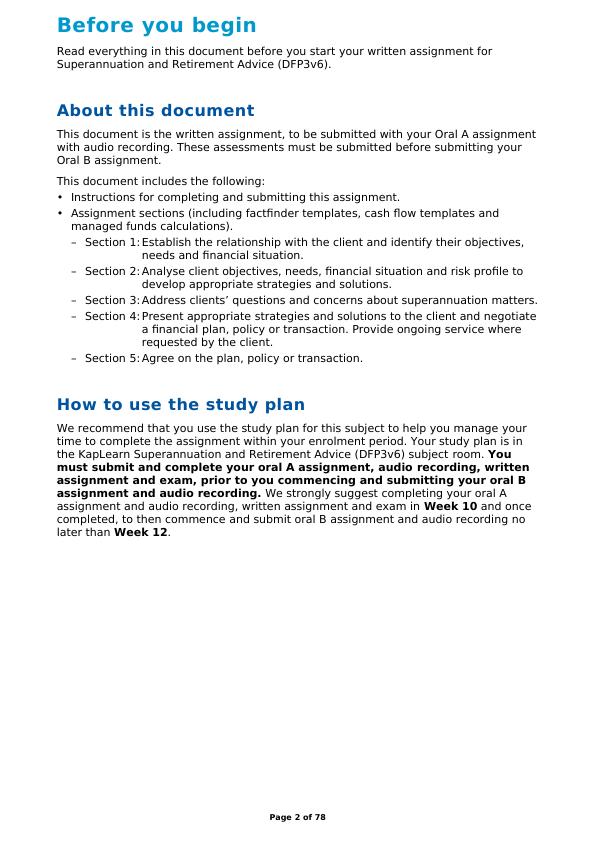
How to use the sample case study and SOA in
KapLearn
The sample case study provides a model to help you prepare your SOA for this
assignment. The case study explains the process that is undertaken to develop the
SOA with reference to an example and it is a very useful resource. Download the
sample SOA and refer to it as you work through the learning materials for this subject.
Before you start work on this assignment, go back to the sample SOA and:
• compare how the SOA matches with the goals and objectives identified in the case
study
• consider what information has been included in the SOA
• consider why this information has been included.
This exercise will help you prepare an SOA for this assignment that addresses your
client’s goals. Please bear in mind that not all SOAs are exactly alike in their
construction, but all have common heading topics within them. Accordingly, there may
be minor differences between the sample SOA and the SOA template in this
assignment. However, all the required compliance elements will be included in both
formats.
Page 3 of 78
KapLearn
The sample case study provides a model to help you prepare your SOA for this
assignment. The case study explains the process that is undertaken to develop the
SOA with reference to an example and it is a very useful resource. Download the
sample SOA and refer to it as you work through the learning materials for this subject.
Before you start work on this assignment, go back to the sample SOA and:
• compare how the SOA matches with the goals and objectives identified in the case
study
• consider what information has been included in the SOA
• consider why this information has been included.
This exercise will help you prepare an SOA for this assignment that addresses your
client’s goals. Please bear in mind that not all SOAs are exactly alike in their
construction, but all have common heading topics within them. Accordingly, there may
be minor differences between the sample SOA and the SOA template in this
assignment. However, all the required compliance elements will be included in both
formats.
Page 3 of 78

Instructions for completing and
submitting this written assignment
Saving your work
Download this document to your desktop, type your answers in the spaces provided
and save your work regularly.
• Use the template provided, as other formats will not be accepted for these
assignments.
• Name your file as follows:
Studentnumber_SubjectCode_Assignment_versionnumber_Submissionnumber
(e.g. 12345678_DFP3_AS_v6_Submission1).
• Include your student ID on the first page of the assignment.
Before you submit your work, please do a spell check and proofread your work to
ensure that everything is clear and unambiguous.
Submitting the written assignment
Only Microsoft Office compatible written assignments submitted in the template file
will be accepted for marking by Kaplan Professional Education. You need to save and
submit this entire document.
Do not remove any sections of the document.
Do not save your completed assignment as a PDF.
The written assignment must be
completed before submitting it to Kaplan Professional
Education. Incomplete written assignments will be returned to you unmarked.
The maximum file size is 20MB for the Written and Oral AAssignment. Once you
submit your written assignment for marking you will be unable to make any further
changes to it.
You are able to submit your written assignment earlier than the deadline if you are
confident you have completed all parts and have prepared a quality submission.
Please refer to the Assignment submission/resubmission instructions (pdf) in
the Assessment section of KapLearn for details on how to submit your written
assignment.
Refer to your study guide so you can plan ahead to complete your audio
recording before the written and oral A assignment is due.
Note: The written assignment (in Word), oral A assignment (in Word) and
audio recording must all be submitted together.
The written assignment marking process
Please note: You have 12 weeks from the date of your enrolment in this subject to
submit your completed oral A assignment and audio recording, written assignment,
exam and oral B assignment and audio recording.
Page 4 of 78
submitting this written assignment
Saving your work
Download this document to your desktop, type your answers in the spaces provided
and save your work regularly.
• Use the template provided, as other formats will not be accepted for these
assignments.
• Name your file as follows:
Studentnumber_SubjectCode_Assignment_versionnumber_Submissionnumber
(e.g. 12345678_DFP3_AS_v6_Submission1).
• Include your student ID on the first page of the assignment.
Before you submit your work, please do a spell check and proofread your work to
ensure that everything is clear and unambiguous.
Submitting the written assignment
Only Microsoft Office compatible written assignments submitted in the template file
will be accepted for marking by Kaplan Professional Education. You need to save and
submit this entire document.
Do not remove any sections of the document.
Do not save your completed assignment as a PDF.
The written assignment must be
completed before submitting it to Kaplan Professional
Education. Incomplete written assignments will be returned to you unmarked.
The maximum file size is 20MB for the Written and Oral AAssignment. Once you
submit your written assignment for marking you will be unable to make any further
changes to it.
You are able to submit your written assignment earlier than the deadline if you are
confident you have completed all parts and have prepared a quality submission.
Please refer to the Assignment submission/resubmission instructions (pdf) in
the Assessment section of KapLearn for details on how to submit your written
assignment.
Refer to your study guide so you can plan ahead to complete your audio
recording before the written and oral A assignment is due.
Note: The written assignment (in Word), oral A assignment (in Word) and
audio recording must all be submitted together.
The written assignment marking process
Please note: You have 12 weeks from the date of your enrolment in this subject to
submit your completed oral A assignment and audio recording, written assignment,
exam and oral B assignment and audio recording.
Page 4 of 78
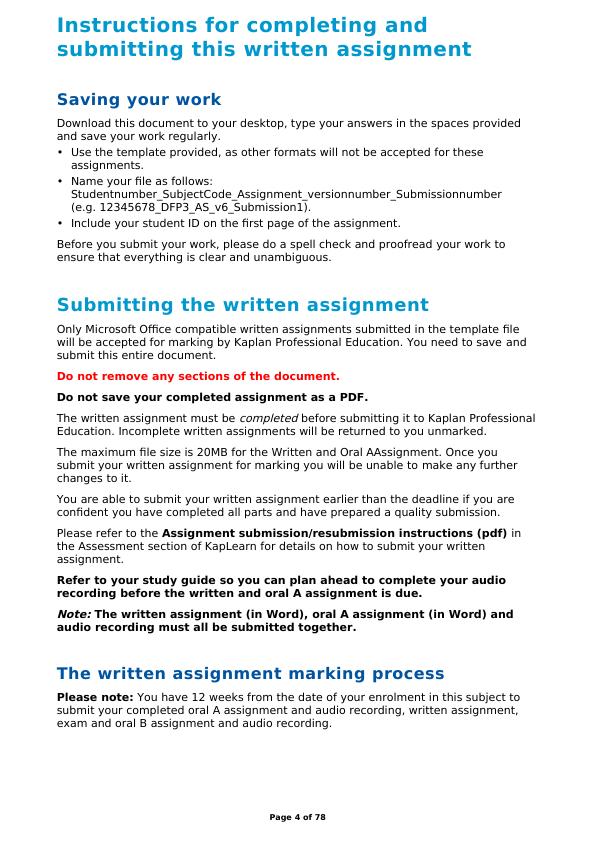
You must submit and complete your oral A assignment, audio recording,
written assignment and exam, prior to you commencing and submitting your
oral B assignment and audio recording. We strongly suggest completing your oral
A assignment and audio recording, written assignment and exam in Week 10 and
once completed, to then commence and submit oral B assignment and audio
recording no later than Week 12.
If you reach the end of your initial enrolment period and have been deemed ‘Not Yet
demonstrated’ in one or more assessment items, then an additional four (4) weeks will
be granted, provided you attempted all assessment tasks during the initial enrolment
period. Please note, you must complete all the assessments in Oral A assignment,
audio recording, written assignment and exam prior to commencing and submitting
your Oral B assignment and audio recording.
Your assessor will mark your assignments and return them to you in the subject room
in KapLearn under the ‘Written and Oral Assessment’ page.
Make a reasonable attempt
You must demonstrate that you have made a reasonable attempt to answer all of the
questions in your written assignment. Failure to do so will mean that your assignment
will not be accepted for marking; therefore, you will not receive the benefit of
feedback on your submission.
If you do not meet these requirements, you will be notified. You will then have until
your submission deadline to submit your
completed written and oral A assignment.
How your written assignment is graded
Assignment tasks are used to determine your ‘competence’ in demonstrating the
required knowledge and/or skills for each subject. As a result, you will be graded as
either ’demonstrated’ or ‘not yet demonstrated’.
Your assessor will follow the below process when marking your written assignment:
• Assess your responses to each question, and sub-parts if applicable, and then
determine whether you have demonstrated competence in each question.
• Determine if, on a holistic basis, your responses to the questions have
demonstrated overall competence.
You must be deemed to be ‘demonstrated’ in all assessment items in order
to be awarded the units of competency in this subject, including:
• all of the exam questions
• the written and oral A and oral B assignment.
Page 5 of 78
written assignment and exam, prior to you commencing and submitting your
oral B assignment and audio recording. We strongly suggest completing your oral
A assignment and audio recording, written assignment and exam in Week 10 and
once completed, to then commence and submit oral B assignment and audio
recording no later than Week 12.
If you reach the end of your initial enrolment period and have been deemed ‘Not Yet
demonstrated’ in one or more assessment items, then an additional four (4) weeks will
be granted, provided you attempted all assessment tasks during the initial enrolment
period. Please note, you must complete all the assessments in Oral A assignment,
audio recording, written assignment and exam prior to commencing and submitting
your Oral B assignment and audio recording.
Your assessor will mark your assignments and return them to you in the subject room
in KapLearn under the ‘Written and Oral Assessment’ page.
Make a reasonable attempt
You must demonstrate that you have made a reasonable attempt to answer all of the
questions in your written assignment. Failure to do so will mean that your assignment
will not be accepted for marking; therefore, you will not receive the benefit of
feedback on your submission.
If you do not meet these requirements, you will be notified. You will then have until
your submission deadline to submit your
completed written and oral A assignment.
How your written assignment is graded
Assignment tasks are used to determine your ‘competence’ in demonstrating the
required knowledge and/or skills for each subject. As a result, you will be graded as
either ’demonstrated’ or ‘not yet demonstrated’.
Your assessor will follow the below process when marking your written assignment:
• Assess your responses to each question, and sub-parts if applicable, and then
determine whether you have demonstrated competence in each question.
• Determine if, on a holistic basis, your responses to the questions have
demonstrated overall competence.
You must be deemed to be ‘demonstrated’ in all assessment items in order
to be awarded the units of competency in this subject, including:
• all of the exam questions
• the written and oral A and oral B assignment.
Page 5 of 78

‘Not yet demonstrated’ and resubmissions
Should sections of your assignment be marked as ‘not yet demonstrated’ you will be
given an additional opportunity to amend your responses so that you can demonstrate
your competency to the required level.
You must address the assessor’s feedback in your amended responses. You only need
amend those sections where the assessor has determined you are ‘not yet
demonstrated’.
Make changes to your original submission. Use a different text colour for your
resubmission. Your assessor will be in a better position to gauge the quality and
nature of your changes. Ensure you leave your first assessor’s comments in your
assignment, so your second assessor can see the instructions that were originally
provided for you. Do not change any comments made by a Kaplan assessor.
Units of competency
This written assignment is your opportunity to demonstrate your competency against
these units:
FNSFPL503 Develop and prepare financial plan
FNSFPL504 Implement financial plan
FNSFPL505 Review financial plans and provide ongoing service
FNSASICU503 Provide advice in superannuation
FNSASICZ503 Provide advice in financial planning
We are here to help
If you have any questions about this written assignment, you can post your query at
the ‘Ask your Tutor’ forum in your subject room. You can expect an answer within 24
hours of your posting from one of our technical advisers or student support staff.
Page 6 of 78
Should sections of your assignment be marked as ‘not yet demonstrated’ you will be
given an additional opportunity to amend your responses so that you can demonstrate
your competency to the required level.
You must address the assessor’s feedback in your amended responses. You only need
amend those sections where the assessor has determined you are ‘not yet
demonstrated’.
Make changes to your original submission. Use a different text colour for your
resubmission. Your assessor will be in a better position to gauge the quality and
nature of your changes. Ensure you leave your first assessor’s comments in your
assignment, so your second assessor can see the instructions that were originally
provided for you. Do not change any comments made by a Kaplan assessor.
Units of competency
This written assignment is your opportunity to demonstrate your competency against
these units:
FNSFPL503 Develop and prepare financial plan
FNSFPL504 Implement financial plan
FNSFPL505 Review financial plans and provide ongoing service
FNSASICU503 Provide advice in superannuation
FNSASICZ503 Provide advice in financial planning
We are here to help
If you have any questions about this written assignment, you can post your query at
the ‘Ask your Tutor’ forum in your subject room. You can expect an answer within 24
hours of your posting from one of our technical advisers or student support staff.
Page 6 of 78
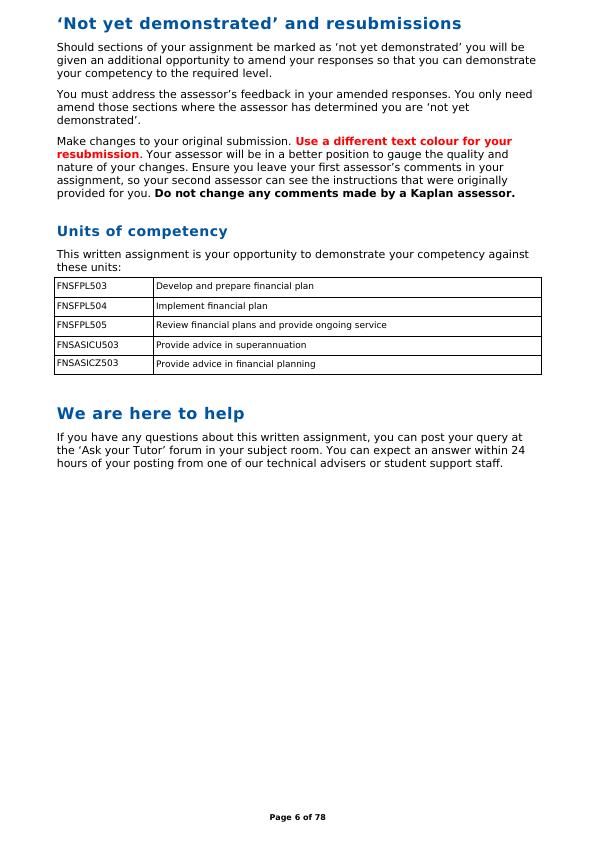
Case study — Nathan and Mary Davidson
You are a financial planner for AFS licensee EANWB Financial Planning. Nathan and
Mary Davidson have been undertaking their own research into planning their
retirement, and recently attended one of your firm’s retirement seminars. After this
seminar they spoke with you about their concerns that they may not accumulate
enough money in superannuation to fund their retirement.
You met with them and during your initial meeting you provided them with some basic
information, including a fact finder for them to fill out. You then organised a second
meeting, at which you collected more information on their current financial situation
and spent time clarifying their needs and objectives.
A summary of their financial situation,based on your interviews with the clients,is
provided below. The completed fact finder,including the risk profile questionnaire,can
be found on page 11 of this assignment.
Current situation
Nathan, age 54, and Mary, age 52, are married and have two children, Jonathan and
Sarah, who are nearing the end of their schooling.
They own their own home, valued at $600,000, and have recently received an
inheritance from the estate of Mary’s mother.
Although theyhave cleared their mortgage,they still have access to a redraw facility of
$100,000. However, they do not want to access this unless there is as an emergency.
Nathan is a full-time sales representative for an agricultural supplies company. He
earns $140,000 annually plus superannuation guarantee (SG) contributions from his
employer paid into the employer’s default fund.
Mary is primarily a self-employed marketing consultant and has business income net
of expenses of $65,000 annually. She also works as a contracted employee in a mining
engineering company. Her hours vary, but typically she earns about $5,600 annually,
plus SG which is paid into the employer’s default fund.
Jonathan and Sarah attend a private school and Nathan and Mary pay a total of $7,000
annually in fees, uniforms, books, school trips etc.
The only other assets they have are their two cars.
Superannuation
Nathan has $270,000 in his superannuation fund and Mary has $99,000. They are both
invested in the default balanced option. Further details of their superannuation are in
the fact find (Appendix 1).
Neither Nathan nor Mary has made any personal contributions to their superannuation
fund.
Nathan’s employer will allow salary sacrificing to superannuation without impacting on
any other employee benefits and will maintain his SG contribution based on his pre-
salary sacrifice income.
Mary’s employer will not allow her to salary sacrifice to superannuation, but does
make SG contributions to her superannuation fund.
Nathan and Mary are happy with their current superannuation funds and the
underlying investments they are invested in. They do not wish to receive advice in
regard to changing their funds or investment portfolios.
Page 7 of 78
You are a financial planner for AFS licensee EANWB Financial Planning. Nathan and
Mary Davidson have been undertaking their own research into planning their
retirement, and recently attended one of your firm’s retirement seminars. After this
seminar they spoke with you about their concerns that they may not accumulate
enough money in superannuation to fund their retirement.
You met with them and during your initial meeting you provided them with some basic
information, including a fact finder for them to fill out. You then organised a second
meeting, at which you collected more information on their current financial situation
and spent time clarifying their needs and objectives.
A summary of their financial situation,based on your interviews with the clients,is
provided below. The completed fact finder,including the risk profile questionnaire,can
be found on page 11 of this assignment.
Current situation
Nathan, age 54, and Mary, age 52, are married and have two children, Jonathan and
Sarah, who are nearing the end of their schooling.
They own their own home, valued at $600,000, and have recently received an
inheritance from the estate of Mary’s mother.
Although theyhave cleared their mortgage,they still have access to a redraw facility of
$100,000. However, they do not want to access this unless there is as an emergency.
Nathan is a full-time sales representative for an agricultural supplies company. He
earns $140,000 annually plus superannuation guarantee (SG) contributions from his
employer paid into the employer’s default fund.
Mary is primarily a self-employed marketing consultant and has business income net
of expenses of $65,000 annually. She also works as a contracted employee in a mining
engineering company. Her hours vary, but typically she earns about $5,600 annually,
plus SG which is paid into the employer’s default fund.
Jonathan and Sarah attend a private school and Nathan and Mary pay a total of $7,000
annually in fees, uniforms, books, school trips etc.
The only other assets they have are their two cars.
Superannuation
Nathan has $270,000 in his superannuation fund and Mary has $99,000. They are both
invested in the default balanced option. Further details of their superannuation are in
the fact find (Appendix 1).
Neither Nathan nor Mary has made any personal contributions to their superannuation
fund.
Nathan’s employer will allow salary sacrificing to superannuation without impacting on
any other employee benefits and will maintain his SG contribution based on his pre-
salary sacrifice income.
Mary’s employer will not allow her to salary sacrifice to superannuation, but does
make SG contributions to her superannuation fund.
Nathan and Mary are happy with their current superannuation funds and the
underlying investments they are invested in. They do not wish to receive advice in
regard to changing their funds or investment portfolios.
Page 7 of 78
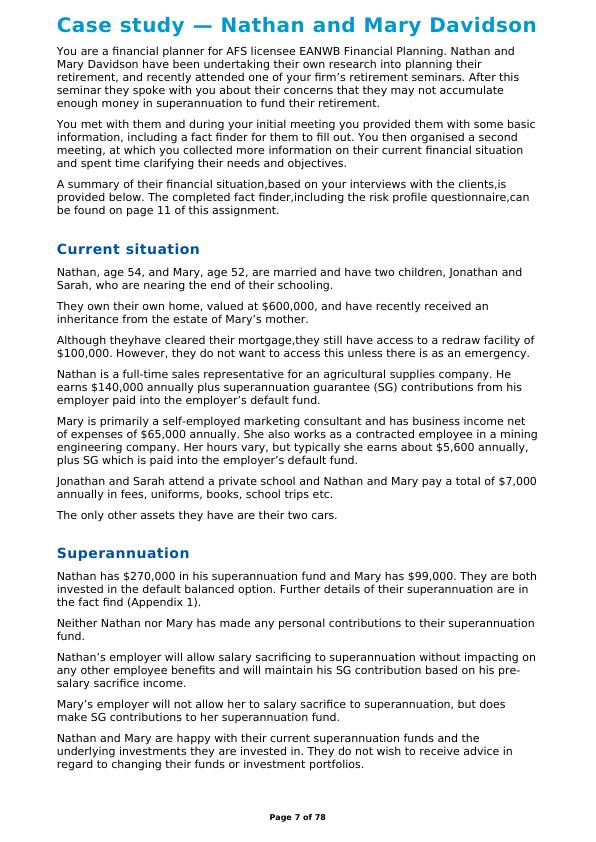
Insurance
Nathan and Mary’s their life insurance and total and permanent disability (TPD)
insurance are owned by their superannuation funds.
Nathan and Mary both have self-owned trauma policies and income protection
policies. Mary also has business overheads insurance.
Their cars are comprehensively insured and they have home building and contents
insurance cover including legal liability cover.
Nathan and Mary have family private health insurance cover.
Further details on their insurance policies are in the fact find.
They have specifically stated that they do not require any advice on their insurance
policies.
Investments
Nathan and Mary have not had any investments other than their superannuation.
Surplus income had been used to pay off their mortgage.
However, they do have $350,000 in their savings account that was left over from the
inheritance from Mary’s mother’s estate after paying off their mortgage. This savings
account, which is their bank’s ordinary transaction account, does not pay any interest.
Other information
Nathan and Mary have a credit card with a limit of $30,000 that they use for all their
general expenses and entertainment. However, they never spend up to their limit and
their average expenses are $7,500 per month, which they repay within the interest-
free period.
Nathan and Mary take regular annual holidays with their children, and spend
approximately $10,000 per trip.
Other expenses include deductible charity donations of $1,220 and accountant’s
expenses of $500 annually.
Needs and objectives
Nathan and Mary are concerned they will not have enough money to provide an
adequate income in retirement. They do not want to rely on the age pension and
would like to be fully self-sufficient if possible.
After your initial meeting with them, they reviewed their situation and decided they
would like you to prepare advice using a retirement income of $80,000 a year (in
today’s dollars). They based this figure on their current spending after deleting items
that will not apply after retirement (such as school fees) and considering their desired
lifestyle in retirement. They have used their bank’s ‘Retirement Projector’ and
determined that if they live to age 95 and earn 4% (net of inflation) on their
investments, they will need almost $1.3 million in retirement savings when Nathan is
age 65.
Nathan and Mary would like to channel their surplus income into their retirement
planning now that they do not owe anything on their mortgage.
Page 8 of 78
Nathan and Mary’s their life insurance and total and permanent disability (TPD)
insurance are owned by their superannuation funds.
Nathan and Mary both have self-owned trauma policies and income protection
policies. Mary also has business overheads insurance.
Their cars are comprehensively insured and they have home building and contents
insurance cover including legal liability cover.
Nathan and Mary have family private health insurance cover.
Further details on their insurance policies are in the fact find.
They have specifically stated that they do not require any advice on their insurance
policies.
Investments
Nathan and Mary have not had any investments other than their superannuation.
Surplus income had been used to pay off their mortgage.
However, they do have $350,000 in their savings account that was left over from the
inheritance from Mary’s mother’s estate after paying off their mortgage. This savings
account, which is their bank’s ordinary transaction account, does not pay any interest.
Other information
Nathan and Mary have a credit card with a limit of $30,000 that they use for all their
general expenses and entertainment. However, they never spend up to their limit and
their average expenses are $7,500 per month, which they repay within the interest-
free period.
Nathan and Mary take regular annual holidays with their children, and spend
approximately $10,000 per trip.
Other expenses include deductible charity donations of $1,220 and accountant’s
expenses of $500 annually.
Needs and objectives
Nathan and Mary are concerned they will not have enough money to provide an
adequate income in retirement. They do not want to rely on the age pension and
would like to be fully self-sufficient if possible.
After your initial meeting with them, they reviewed their situation and decided they
would like you to prepare advice using a retirement income of $80,000 a year (in
today’s dollars). They based this figure on their current spending after deleting items
that will not apply after retirement (such as school fees) and considering their desired
lifestyle in retirement. They have used their bank’s ‘Retirement Projector’ and
determined that if they live to age 95 and earn 4% (net of inflation) on their
investments, they will need almost $1.3 million in retirement savings when Nathan is
age 65.
Nathan and Mary would like to channel their surplus income into their retirement
planning now that they do not owe anything on their mortgage.
Page 8 of 78
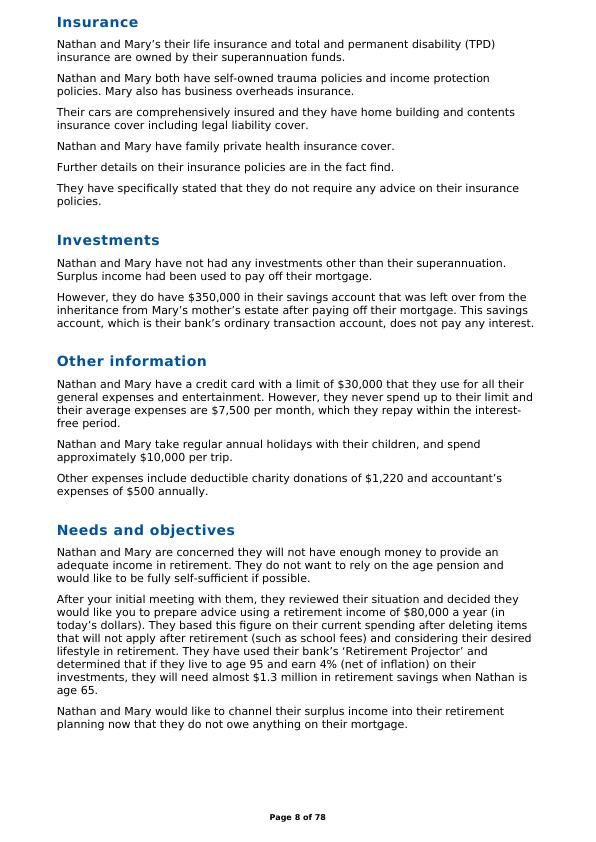
End of preview
Want to access all the pages? Upload your documents or become a member.
Related Documents
Superannuation and Retirement Planninglg...
|78
|19574
|337
Superannuation and Retirement Planning-Writtenlg...
|136
|20443
|79
Superannuation and Retirement Planning - DFP3_AS_v4lg...
|77
|21153
|223
Preparation for Oral Assignment - Deskliblg...
|23
|7884
|57
Certificate IV in Finance and Mortgage Broking Oral Assignmentlg...
|33
|9481
|116
Written Assignment Marking Guidelg...
|77
|18937
|450